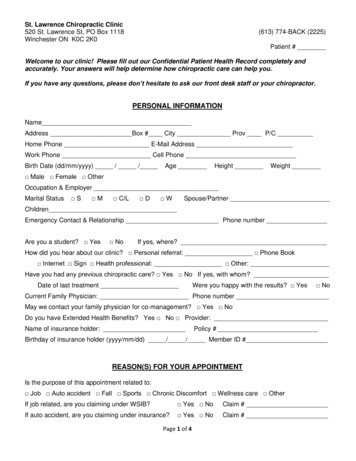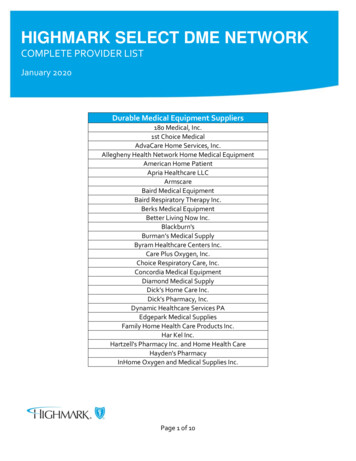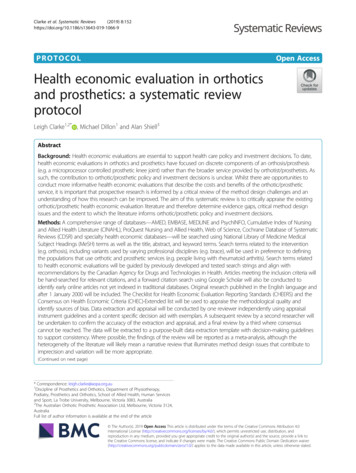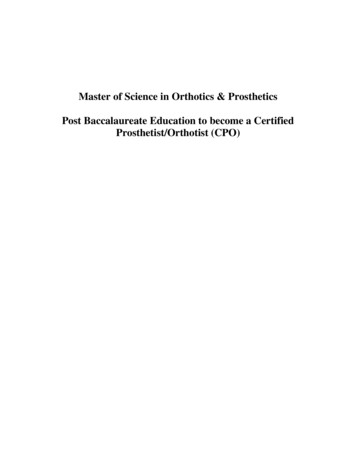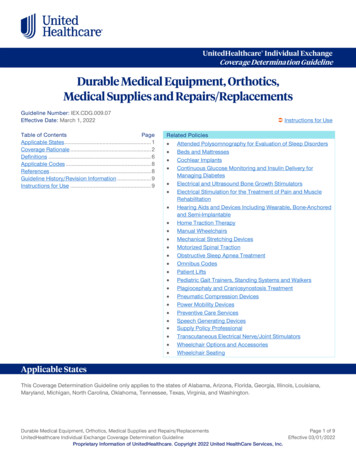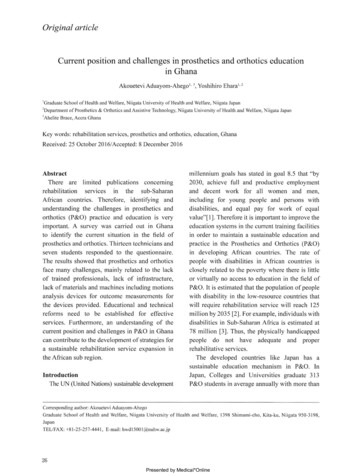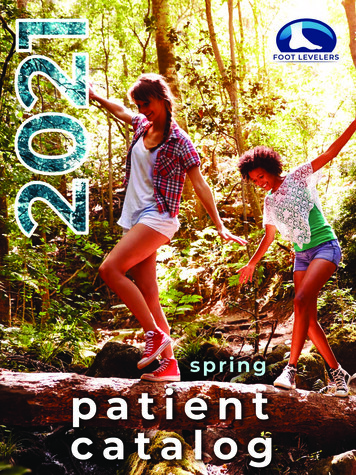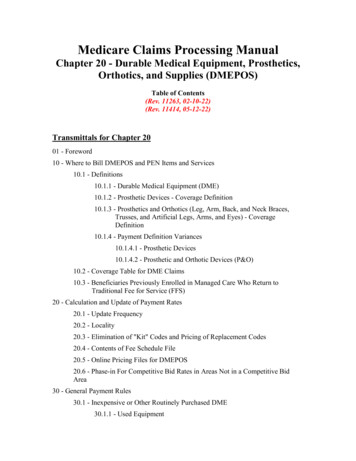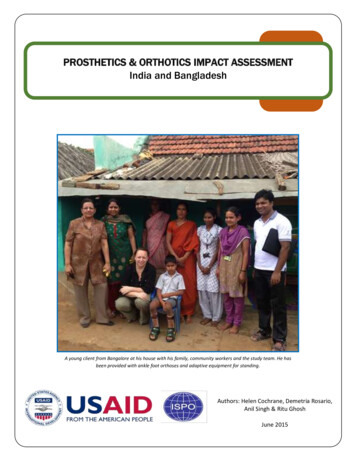
Transcription
PROSTHETICS & ORTHOTICS IMPACT ASSESSMENTIndia and BangladeshA young client from Bangalore at his house with his family, community workers and the study team. He hasbeen provided with ankle foot orthoses and adaptive equipment for standing.Authors: Helen Cochrane, Demetria Rosario,Anil Singh & Ritu GhoshJune 2015
AcknowledgementsThe impact assessment was funded by the United States Agency for International Development (USAID). TheInternational Society for Prosthetics and Orthotics (ISPO) appreciates the support of USAID in strengthening ourunderstanding of prosthetics and orthotics training and services.The authors are grateful to all of the participants in this study, especially the graduates, clients and the individual peoplewith disabilities and their families who shared their stories with us.In addition the authors would like to thank Mr. Rajdeep Kumar from India and Mr. Imran Shoaib S.M. from Bangladesh,the local liaison officers for their respective field visits. We also extend our gratitude to representatives from theGovernment Ministries in India, non-governmental organisations in India and Bangladesh, as well as the Directors andManagers in all of the centres visited. Edited by Sandra Sexton, Angie Weatherhead and Diana Corrick.Together we will continue moving beyond physical disabilityInternational Society for Prosthetics and Orthotics22-24 Rue du LuxembourgBE-1000 Brussels, BelgiumTelephone: 32 2 213 1 79E-mail: ispo@ispoint.orgWebsite: www.ispoint.org1
Contents:Section12345678910ContentExecutive SummaryIntroduction and contextMethodologyISPO certified graduates in India and BangladeshHow services impact on lives – client storiesServices in IndiaServices in BangladeshSummary and RecommendationsGlossary of acronymsReferencesAppendices are available separately:Appendix 1Appendix 2Appendix 3Appendix 4Appendix 5Appendix 6Appendix 7Appendix 8Appendix 9Appendix 102Causal modelFramework for studying impactDiscussion guidesGraduate interview form pages 1-2Graduate interview form pages 3-6: lower limb prostheticsGraduate interview form pages 3-6: lower limb orthoticsGraduate interview form page 7Participant information sheetClient participant information sheetConsent formPage3458152329353940
Section 1: Executive SummaryIn South Asia the need for services that mitigate the effects of disabilities is clear as population based estimates reportthe number of persons with disabilities at 10%1. For India and Bangladesh with a combined population of almost 1.4billion and an estimate of more than 9 million persons2 with mobility related disabilities the need for prosthetics andorthotics services is amply demonstrated.Mobility India is the only ISPO recognised program in India offering training for ISPO Category II single discipline. At thetime of the study since 2002 Mobility India has enrolled two hundred and twenty-one students.Our study was conducted in association with ISPO’s current USAID funded programme: ‘Rehabilitation of physicallydisabled people in developing countries’. We carried out field visits to India and Bangladesh, interviewed Ministryofficials, Heads of Clinical Services and Heads of Prosthetic and Orthotic Departments. We conducted a partial audit ofgraduate clinical skills and competencies and determined the professional development needs of graduates in selectedSouth-East Asian countries. We also listened to service users, hearing stories of how services had directly impacted upontheir lives.During the field visit there was evidence that ISPO recognised graduates from Mobility India had a positive impact on: The establishment of services in BangladeshThe on-going development of standards for clinical services and prosthetic/orthotic education in IndiaThe overall appropriateness of prosthetic /orthotic servicesProfessional communities and collaborationsThe long-term sustainability of prosthetic /orthotic servicesThe most profound impact appeared to be on the lives of persons with disabilities and their families. Repeatedly theteam heard from the volunteer patients how the devices had positively influenced their independence throughincreased access to employment, education, social activities and their community. The devices allowed the patients tonot only contribute to the social and economic development of their community, but to aspire to far more than they hadpreviously thought possible. Families reported that the impact of devices delivered to their loved ones had also changedtheir lives, with parents seeing a future for their children that had once been unimaginable. Many individuals reportedfeeling less fear of the future and their entire family experienced less of the stigma commonly associated with beingrelated to a person with disabilities in these countries.In both countries ISPO recognised graduates had good working relationships with other disciplines, worked at or abovethe level expected of an ISPO Category II graduate of a single discipline and were sought after and well respected byemployers. Limitations exist in both countries with respect to resources in terms of both the size and profile of theworkforce, and in infrastructure and fiscal/material resources. This study has made 22 recommendations to help tofurther develop prosthetic and orthotic services.Helen Cochrane, CPO (Canada) MScISPO Study Team Lead3
Section 2: Introduction and contextThe International Society for Prosthetics and Orthotics (ISPO) certifies prosthetists/orthotists (ISPO Category I) ororthopaedic technologists (ISPO Category II) graduating from ISPO evaluated courses of study. ISPO has a programme ofactivity grant funded by the United States Agency for International Development (USAID) named ‘Rehabilitation ofphysically disabled people in developing countries’. One of the objectives of the grant is to assess the impact of ISPOCategory I and II training.In South Asia the need for services that mitigate the effects of disabilities is clear as population based estimates reportthe number of persons with disability at 10%1. For India and Bangladesh with a combined population of almost 1.4 billionpeople and an estimated more than 9 million persons2 with mobility related disabilities, the need for prosthetics andorthotics services is amply demonstrated.Mobility India (MI) is the only ISPO recognised programme in India offering a range of training from ISPO Category IIsingle discipline courses to educating community level workers tasked with increasing awareness of disabilities, relatedissues and livelihood programs to alleviate poverty associated with disabilities. MI targets India’s underservedsouthern, eastern and north eastern region with service delivery and education. The training centre is located inBangalore in the southern state of Karnataka. The school is open to applicants from across India as well as internationalenrolment and there are students from across the region. At the time of the study, since 2002 MI has enrolled 221students with 44% of enrolments being international students, primarily from 13 countries from Asia and Africa. 25% ofstudents are people with disabilities. MI has received support from USAID through a scholarship program to train ISPOCategory II single discipline prosthetic and/or orthotic professionals. Since 2009 USAID has sponsored 23 professionals,20 males and 3 females, 11 in prosthetic practice and 12 in orthotic practice, from six countries (Bangladesh, Nepal,India, Malawi, Yemen and Angola). MI has also received direct grants from USAID for a twenty-seven month project tosupport improvements in rehabilitation therapy programmes in eight conflict-affected states in India.We considered various ways to measure impact frompublished literature and used the USAID ImpactAssessment Primer Series as guidance3 and developed acausal model and analysis framework. The aim was to testour hypothesis that: “Training personnel to ISPO CategoryI and II standards provides basic knowledge, skills andexperience to enable them to offer and/or improveprosthetic and orthotic services for persons with physicaldisabilities.”Figure 1. Map of Southern Asia highlighting India and Bangladesh.4
Section 3: MethodologyThis impact assessment focussed on completing a partial audit within 2 countries where graduates of an ISPO recognisedprogramme were working. Each national follow up of graduates reported on:1. Country context and rehabilitation, prosthetics and orthotics services.2. Discussions with government officials, head of services, prosthetics and orthotics service managers.3. Interviews with graduates together with their clients.The assessment was conducted by the authors during site visits to the countries from 7th to 15th August 2013.1. Country context and rehabilitation, prosthetics and orthotics servicesDesk based research was augmented by tours of national, regional and local prosthetics and orthotics facilities.2. Discussions with government officials, head of services, prosthetics and orthotics service managersLetters of invitation were sent to government officials and heads of services with email or telephone recruitment ofprosthetics and orthotics services managers. Discussion guides were used in the following meetings:A. Courtesy visits with government ministries involved with the delivery of prosthetics & orthotics services:This helped determine the commitment of Governments to develop services for persons with physicaldisabilities.B. Meetings with directors of hospital services: This helped determine the history and development of services andfacilities, in addition to how prosthetics and orthotics fitted into the overall scheme of services. The servicestructure and the user population were also explored.C. Meetings with prosthetic/orthotic services managers: This helped determine the staff profile and established theimpact of having graduate personnel working in a prosthetic/orthotic service. Furthermore, leadership, nationalrecognition and service development were discussed.3. Interviews with graduates together with their clientsThis part of the study had a specific methodology which involved one hour interviews with graduates.Title: A study of professional skills and development needs of clinical personnel in prosthetics and orthotics in lowerincome countries.Investigators: Study investigators led a structured interview with study participants. In each study, investigators wereselected from the formal list of ISPO evaluators, regional programme heads and/or key senior personnel who haveextensive postgraduate experience.Location: The study was conducted in the workplace; in one or more prosthetic/orthotic clinics in India and Bangladesh.Objectives of investigation: The study addressed the wider programme objective to assess the impact of ISPO Category Ior II training on: the end user of prosthetic and orthotic devices the quality of prosthetic/orthotic treatmentThis Graduate Audit survey specifically aimed to: determine the scope and level of professional practice audit MI graduate skills determine the professional development needs of the graduates5
ISPO Category I and II training aligns with ISPO published professional profiles for prosthetist /orthotists (ISPO CategoryI) and orthopaedic technologists (ISPO Category II) 4.Nature of the participants: ISPO certified graduates of MI working in India and Bangladesh with at least 1 year postgraduate experience and having a scope of practice in lower limb prosthetics and/or lower limb orthotics patientmanagement.Consents: Written consent was sought from graduate participants following the provision of a Participant InformationSheet. Clients/patients were asked to verbally consent to their involvement following a defined verbal explanation bytheir participating clinician in the local language.Recruitment of participants: Potential participants were identified from the graduate lists supplied by MI and verifiedthrough the ISPO list of certified professionals. Following study recruitment by letter, email or telephone invitation fromthe programme head, visits to graduates in the clinical settings were arranged in India (Bangalore, Chamrajnagar andKolkata) and Bangladesh (Dhaka). A convenience sample was selected depending on where graduates worked, theavailable time and budget for each field visit and flight itineraries. The graduates selected client participants.Structured interview: A structured interview was developed, building on past graduate follow-up work conducted byISPO over the last decade and funded by USAID. The protocol was recently re-developed following a 2010 graduate auditfield trip to Vietnam and then validity testing with two experienced clinicians in Ethiopia and Tanzania. Further to this,the structured interview data collection forms were redesigned to enable improved ease of use. The method was thenapplied in an East Africa impact assessment. The most recent methodology was presented here.Prior to entering the interview, the graduates were given a 2 page form to complete regarding demographic data aboutthemselves and their client. They also answered questions about professional practice. Each participating graduate wasthen interviewed about lower limb clinical care at the end of a client review appointment both with their client (part A)and then without their client present (part B). A data collection form was used and this also acted as an aide memoir toprompt areas for further discussion during the interview.PART A: With the client present, the interviewer asked the graduate to present their client case. The interviewer tooknotes on the data collection form during the interview which covered competencies expected of an ISPO certifiedprofessional. This part of the interview took about 30 minutes to complete.PART B: Once the client had left, the interviewer reviewed the interview form with the graduate and identified at least 3areas for clinical practice development that the graduate could work on alone. It was estimated that this part of theinterview took about 30 minutes to complete.Where graduates demonstrated consistent good practice, other development needs were discussed. At the end of theinterview participants were given a note of feedback and a personal development plan.Independent scrutiny: The methodology was reviewed by Dr Angus K McFadyen, Statistical Consultant from AKM-STATS,Glasgow, Scotland, UK, with a request for advice about the questionnaire design and the intent to perform exploratorydata analysis. The methodology was then improved prior to use.Data collection, storage and security: Data collection was undertaken by the investigators using the structured interviewprocess and hard copy data collection form. Data was made anonymous when electronically processed. Both raw dataand electronic data are securely held by the ISPO programme manager, and remain the property of USAID until at least 3years after the last date of the programme (3 years after 31 December 2015). At this point the data will be destroyed.6
Potential risks or hazards: No risks were identified.Ethical issues: Participation was voluntary. All forms were coded and no identifying information has been provided in anystudy report.Any payment to be made: Participant travel and subsistence expenses were provided for people away from home forover 2 hours.Participant debriefing: Participants were immediately given their feedback and a personal development plan. Onceavailable, participants will be sent a copy of this final study report.Outcomes dissemination: The outcomes of the study will be widely published on the ISPO website, presented atconferences and submitted to peer reviewed journals.7
Section 4: ISPO certified graduates in India & BangladeshIn the last ten years MI has trained ISPO Category II prosthetists and/or orthotists. At the time of the study no ISPOCategory I recognised programmes existed in India. India and Bangladesh were selected as countries for field visits forinclusion in the impact assessment because each county has a sizeable MI alumni population. Five centres in India andthree centres in Bangladesh were visited to assess the graduates of the ISPO recognised programme.Graduate participants in this impact studyA sample of 24 ISPO certified graduates entered the study, 115 in India and 9 in Bangladesh. The average age of the MIgraduate participants was 29 years old ranging from 24 to 44 years. We saw 17% of all MI ISPO Certified Indianpersonnel, and 39% of all MI graduated Bangladeshi personnel. 38% of the sample was female (compared with 30% of allMI Category II graduates). The average number of years since graduation was 5 OCategory CategoryIII01509024Table 1: Graduate participant informationAge 242424443944Averageyearsgraduated645Table 2: Graduate ages and years graduatedProfessional PracticeScope of practice: Of the 24 participants, there were9 graduates who had completed both the prostheticsand orthotics modules at MI. 10 had completed theorthotics module, 5 had completed the prostheticsmodule and none of the graduates had completed theupper limb/spinal module.34% of the participants reported their case-load wasexclusively lower limb orthotics. 21% of the graduatesreported they worked exclusively in lower limbprosthetics. 25% of graduates reported they workedin both lower limb prosthetics and orthotics. 8% ofthe participants reported they worked in all levels ofprosthetic, orthotic and spinal while 8% reported theyworked in upper and lower limb orthotics. Only 1participant reported that their caseload includedupper and lower limb prosthetic interventions.Figure 2Specialist care: 38% of graduates reported theyspecialised in a particular device type or pathology. Most of those who considered themselves specialists includedmultiple areas of specialty.8
Lower limb orthotic devices and related pathologieswere the examples most often provided. For prostheticspecialties congenital short limb was most oftenreported with three graduates listing it as theirspecialty.Activities and caseload mix: On average the graduatesreported they spend 69% of their time delivering directpatient care. Graduates reported 20% of their time isspent supervising others while they provide directpatient care. Graduates reported 7% of their time wasspent on administrative tasks within their centre and4% of their time was spent on administrative tasksoutside their centre.Figure 3Graduates reported that lower limb prosthetics and orthoticcomprised the majority of their case-load with 42% lowerlimb prosthetic and 48% lower limb orthotics.Figure 4Level of competence: Fourteen graduates did not respond to thisquestion. Those who did respond reported feeling most confident inlower limb orthotics with six graduates indicating this as their mostconfident area and four graduates indicating they felt most confident inlower limb prosthetics.Figure 59
Seeking advice for complex cases: All graduates indicatedthat they had someone they could access for advice forcomplex cases. Nineteen graduates indicated they hadaccess to other prosthetists/orthotists, therapists and/ordoctors. Three graduates indicated that they had accessto ISPO Category I prosthetists/orthotists.Figure 6Keeping up to date withinformation: 88% of graduatesreported that they kept up to dateby participating in workshops orseminars and 64% reported thatthey had access to the internet atwork. 28% had access to a medicallibrary, 16% could access theinternet through an internet caféand 8% had home access to theinternet. Only one participantreported accessing full textjournals to keep up to date withinformation.Figure 7Membership of professional bodies and clinical interest groups: 36% of graduates reported being a member of aprofessional body. This thirty-six percent is comprised of nine graduates from Bangladesh who indicated they aremembers of the Bangladesh Society for Prosthetics and Orthotics. None of the graduates from India reported that theywere part of professional body or clinical interest group.Clinical practiceTwenty four MI graduates completed this section and they presented twenty-nine clients. Fifteen orthotic clients andfourteen prosthetic clients were reviewed.In one centre no clients were able to be reviewed as local political unrest in Dhaka forced the change of the evaluationdate at short notice resulting in two graduates being interviewed without their volunteer clients present. Multiplepresentations were done by graduates who had completed both the lower limb prosthetic module and the lower limborthotic module, presenting one volunteer patient from each discipline.10
Referral prescriptions: 14% of case records included a referral from a medical doctor.Clinical records: In most centres clinical records were available with 83% of the cases having some type of recordavailable. However records were only considered to be complete in 31% of cases. Where clinical records wereincomplete there was a range of missing data. 86% did not include a doctors’ referral and medical history was oftennoted as missing as were measurement charts, clinical examinations and specifically gait assessments.History taking: All graduates reported some medical history including how the mechanism of the injury incurred and/orhistory of the disease process. All records included a social history.Description of physical disability: 69% of the graduates listed the functional impact of the client’s disability. 28% alsoreported the impact of the disability on some aspect of the quality of life or activity of an individual client. 24% ofgraduates included no functional impact or quality of life report or commented listing only the cause or diagnosis thatresulted in disability. No graduates indicated that they used a scale or tool to measure or record the degree of disability.Prosthetics and orthotics history: 55% of graduates reported a detailed history. 17% of graduates reported a history butsome details were considered to be missing. In 28% of cases the client was receiving their first device.Physical examination: Most graduates could complete a basic assessment. In many cases some aspects of assessmentwere missing and in some centres the graduates were not always involved in the physical examination. At times thefindings reported were more generalised and did not investigate deeply into the case or condition.Functional rating of user: 69% of graduates reported on the functional grade of the volunteer client they presented.Only one graduate used a scale to determine and report the functional level of the client.Devices meeting client’s needs: Graduates reported that the device provided was meeting their clients’ needs in 100%of cases presented during the study. Most devices displayed signs of being regularly worn and clients reported that thedevices were very helpful to them and meeting their needs.Appropriateness of device: All graduates reported that the device provided met their clients’ needs. In 69% of cases theinvestigators agreed that the device was meeting the clients’ needs given the local context, limited materials andresources. In 17% of cases the investigators thought the device was not meeting the clients’ needs.Prosthetic and orthotic prescription and specification: Twelve of fourteen prosthetic cases presented were trans-tibial,with one bilateral trans-tibial, one extension prosthesis and one trans-femoral case.In general there appeared to be a limited range of components available for prosthetic intervention in the centres thatwere visited. All devices were endo-skeletal, with six resin sockets and nine thermoplastic. Ten of the trans-tibial socketswere patellar tendon bearing design and the only trans-femoral socket presented had a quadrilateral socket. Eleven ofthe feet were solid ankle cushion heel design. There were three Jaipur modular feet and one multi-axis foot. There wereeleven supracondylar suspensions, with one client also using a sleeve to augment suspension. In addition, twocircumferential cuff suspensions were presented. Apart from the trans-femoral, all prosthetic devices included a foamliner for skin interface and/or suspension. The only knee joint presented was a uni-axial knee joint.In total nineteen orthotic devices were seen between the fifteen clients. There were ten ankle-foot orthoses presentedincluding one bilateral case, who also used a knee orthosis for contracture management and a modular standing framefitted by the participating graduate. Six knee-ankle-foot orthotics were presented as well as one foot orthotic and onewrist-hand orthosis. Many of the knee-ankle-foot orthotics used a blend of custom fit ankle foot shells and modularthigh shells with ischial weight bearing brim design.11
Durability of device: Most devices were new with the average age of all devices being six months old. Those that weremore than twelve months old generally showed signs of being used regularly over time. Graduates reported a normalrate of repair/adjustment and plan for follow up.Devices: In all but one case the graduate presenting the case had fabricated the device. In the one case the device hadbeen made by one of the other ISPO Category II graduates working in the same centre.Follow up since delivery: In 55% of cases follow up had been planned and/or completed. Where it had not beencompleted it was usually because the device was recently delivered to the client.Treatment goals identified and noted: In 34% of prosthetic cases the graduates identified a treatment goal and in 66%of prosthetic cases the goals were at least partially identified. The evaluators observed that in 73% of orthotics cases thedeformity and instability in the joints was reduced and/or gait was improved.Improvements for devices seen: In 24% of thecases graduates did not identify any areas ofimprovement. 48% of graduates indicated thatthey would like to change their prescription ifresources allowed. In 21% of cases graduatesidentified that they would like to change the fit oftheir device. The evaluation team generallyagreed with these findings.Figure 8Most beneficial part of professional training: Few graduates identified a specific aspect of their training as mostbeneficial. 17% stated that clinical practice was the most useful part of their training.Topics which could have eported that they wished to learnmore about pathologies anddiseases. They also highlightedlower limb prosthetics and inparticular about socket design fortrans-femoral amputation.12Figure 9
Desire for continuing education courses: Most graduates expressed an interest in completing additional modules tobroaden their clinical scope. When asked specifically about their interest in continuing professional development, higherlevels of amputation and higher level lower limb orthotics were areas where graduates most frequently indicated theywould like to participate in continuing education. These were specifically prosthetic componentry, trans-femoral socketdesign and orthotic management for a condition that indicated a knee-ankle-foot orthosis may benefit the client.Figure 10Desire to introduce new technologies: Graduates most frequently reported that they would like to see an increasedrange of modular components for prosthetics introduced to their centre. Most graduates had a limited awareness of therange of technology that may be available. 66% of graduates did not provide an answer to this question.13Figure 11
Personal development planningThe investigator and graduate reviewed the data collection form without the client present. Three needs were identifiedfor each graduate. The following table shows a summary of the development needs. Where needs were identifiedbecause of the client presentations these were prioritised. Where graduates demonstrated consistently good practiceand there were no further issues with their client presentations, other professional development needs were identifiedthrough discussion.The greatest development need identified was for graduates to improve their clinical skills. The most common areas ofneed were gait assessment, general clinical assessment, foot assessment and the systematic recording and reporting oftheir clinical assessment. Upper limb and spinal interventions were also noted as an area where graduates would benefitfrom development as many were treating these cases in the absence of any formal training.Development needs summaryContinuing professional development needranked by number of times identifiedClinical skills updatesGait assessmentSystematic recording and reportingClinical assessmentFoot assessmentSkin conditionsEngage a clinical mentorGoal settingConditions/pathologiesPolioPaediatric pathologyCerebral palsyStrokeSpasticityProsthetics and Orthotics clinical & technical skillsUpper limb/spinalCommunicationKnee ankle foot orthoticsDevice delivery criteriaAlignment orthoticsSocket designPrescription criteriaBiomechanicsHip disarticulation managementAlignment prostheticsPatient educationOrthotic componentsAnkle foot orthoticsTable 314Number oftimes identified88543321111112432221111111
Section 5: How services impact on lives – client storiesService users clearly made known the life changing impacts that the prosthetics and orthotics services had made on theirlives.In this section we share the feedback that clients gave to their graduate clinicians in response to the question:“What difference has the orthotic/prosthetic service made to the user’s life?”As well as the 29 clients who consented to be presented by the graduates, we also spoke to 6 service users who sharedtheir personal stories with the study team. Their stories better informed us of the ways in which services influenced andenabled them.Client participantsProsthetic clientsConditionsDiabetesn 2Trauma10Congenital2Total14Orthotic clien
southern, eastern and north eastern region with service delivery and education. The training centre is located in Bangalore in the southern state of Karnataka. The school is open to applicants from across India as well as international . Centre for Rehabilitation of the Paralysed (CRP) Dhaka CRP is a non-profit, non-governmental organisation that
